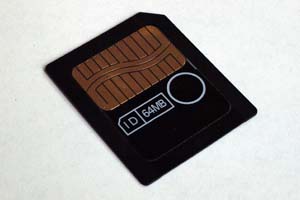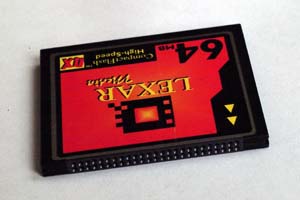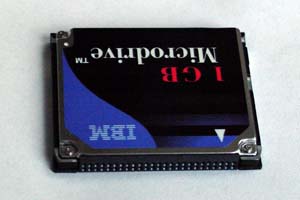 |
 |
|
|
SmartMedia Module |
Compact Flash Module |
Storage Media for Digital Photography
There are two popular storage media formats used in digital cameras, Compact Flash and SmartMedia. (Memory Stick seems to be proprietary to Sony and hence less popular.) Some high-end cameras can use either, but usually your choice of camera dictates your memory format. You may want to consider the strengths and weaknesses of the two formats in your digital camera purchase decision. Here's a comparison between them:
 |
 |
|
|
SmartMedia Module |
Compact Flash Module |
Form Factor - SmartMedia modules are thin (1/32") postage-stamp sized (1.5" x 1.75") cards with exposed gold contacts on one side. They're probably water resistant, possibly even waterproof (they cost enough I haven't tried it). When I handle them, I'm a little concerned I'm going to break them in two, though I've never heard of this happening.
Compact Flash modules are much thicker (1/8") but similar in the other two dimensions, with a multi-pin female connector on one end. Water droplets splashed into the connector would probably kill them. They feel substantial and are easy to handle.
Cost of Media - As of this writing (January 2001), SmartMedia costs about $1.30 per megabyte at the most competitive internet sites. Inexpensive (see below) Compact Flash cards cost about $1.45 per megabyte in the optimum sizes (32MB to 96MB) rising to somewhat above $1.50 per megabyte for the largest cards. If your camera can handle "Type 2" Compact Flash cards (the CP950 and CP990 can't), you can use the 1GB IBM microdrive at $0.44 per megabyte.
Technology - In reality, "SmartMedia" is inappropriately named. SmartMedia cards are actually just raw memory with no smarts at all. The clever part of SmartMedia is the incredibly compact size, which is achieved by mounting the (extra thin) memory chips in the plastic just behind the gold connectors.
Compact Flash, on the other hand, contains a sophisticated controller. It can use multiple memory chips, or even use a tiny hard disk "microdrive" to store the data. The extra thickness of the module means it can be built using a circuit board.
Downloading - Once you take some pictures, you need to transfer them from the memory module to your computer for editing, display and printing. There are several ways to do this:
Serial Transfer is the cheapest (supplied with camera) and slowest way. You'll find it on older cameras, both the CP990 and the C3030 support the faster "USB" transfer instead. It's sufficient to say here that you don't want to use serial transfer.
USB Transfer from Camera has replaced serial transfer as the method that comes "in the box" with your camera. You'll find a cable that connects your camera to your computer's USB port (you need Windows 98, ME or 2000). The transfer speed is limited by the USB speed (relatively slow but not unusable). Both the CP990 and the C3030 have special driver programs that you need to load to your computer to talk to the specific camera. The big problems with this download method are speed, need to use proprietary software, and need to use the camera.
A USB Media Reader allows you to plug your media into the reader (no camera connection required) and read it on your computer like another hard disk drive. These readers cost around $35 for single format, a bit more for universal readers that take both SmartMedia and Compact Flash. You're still limited by the speed of USB, but I recommend this method. There are firewire readers that are faster than the USB models.
A PC Card Adaptor allows you to plug your media into the PC Card slot on your laptop and read it like a hard drive. PC card adaptors for Compact Flash are cheap (the electronics are already in the module), around $10, but SmartMedia PC Card adaptors cost around $30. This is the method I use, and it's very fast.
Available Sizes - This is the arena in which SmartMedia really should be called "Dumb Media." As of this writing, the standards by which SmartMedia can be expanded beyond 128MB have not been established. So any SmartMedia product you buy for the next year or so will be limited to at most 128MB of storage. Worse still, apparently even the standardization to 128MB is uncertain - I've been told by Delkin Devices, who have just announced shipment of their 128MB card, that 128M cards will not work in the Olympus C3030. Take this with a grain of salt because Olympus says it will!
Compact Flash, on the other hand, is available in Type 1 format up to 256MB now, and I expect to see 512MB soon. I don't know what the limit is, but given that Type 2 modules are available at 1GB, I'm not worried.
Performance - SmartMedia, being dumb memory, doesn't vary in performance. With the exception of the Olympus "panorama" bit (see below), all SmartMedia brands are identical.
Compact Flash controllers, on the other hand, do vary in speed. You will find cards claiming 4X, 8X and even 10X performance. That doesn't mean that your camera will take pictures ten times faster, though. It does mean that if the Compact Flash controller is the limiting factor in storage speed (that's a big IF), then these cards will reduce this bottleneck. The bottleneck occurs if you've taken many (ten or so) shots and continue shooting while the data is being moved to the module. With the underwater cameras I'm reviewing, I don't think this is an issue.
Gimmick Features - As mentioned above, Olympus has added an extra bit to their SmartMedia cards, which allows their cameras to indicate that a given picture is taken in "panorama" mode - that is that the exposure between successive shots is identical, and the pictures can be pasted together into a panorama. This is really obnixious. Olympus could easily have placed this information in the .jpg file metadata and allowed its use with any media brand. But they want to be able to charge a premium for their modules, so they locked it into the hardware. In cases like this, I advocate boycotting the Olympus media to teach manufacturers that such strategies are bad business. End soapbox mode.
Compact Flash cards can now be "USB Enabled". This feature means that the smart controller in the card includes a USB interface, and you can plug the card via a cheap ($20) cable directly into your USB port. Since I use the (faster) PC Card interface, it's of little interest to me, but if it gets cheap enough it's a reasonable approach.
 |
CF Type 1 and Type 2 - I've mentioned type 2 Compact Flash cards a few times. The ONLY difference between the two types is the thickness. ( Type I is 3.3 mm and CF Type II cards is 5mm thick.) The electrical interface is identical. Still, some cameras (notably the CP990) won't accommodate Type 2 modules. Dumb. |
3.3V or 5V - Both the SmartMedia and Compact Flash standards existed as modern electronics went from the old standard 5V power supply to 3.3V. Modern cameras (such as the C3030 and the CP950 and 990) all use 3.3V, and the larger memory cards (64MB and beyond) all use 3.3V. My advice is to ignore the 5V issue entirely.
Summary - The modules are both so tiny that the extra size of the Compact Flash doesn't bother me. I'm careful enough anyway about water near electronics that the SmartMedia advantage is no big factor either. The difference in price is also of little consequence. But I really want plenty of photo capacity, and I can't get enough from SmartMedia. I strongly prefer cameras that support Compact Flash. In fact, I'm critical of the CP990 for not supporting Type 2 Compact Flash. It seems to me that engineers still have failed to learn from IBM's 640K mistake in the original PC - there's no such thing as too much memory capacity!